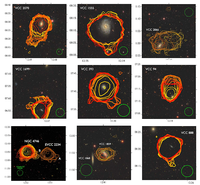Ram Pressure Stripping
The baryon cycle in galaxies describes how they accumulate, process, and expel gas. All of these are essential in understanding the lives of galaxies, but studying how they lose gas – how galaxies die – is of particular interest to me. Radio observations can help us catch it in the act, showing the gas in long streams and tails at the very moment it's being lost. That's potentially more informative about the basic physics at work than statistically inferring what might be going on by studying the average gas contents of galaxies in different environments.
In galaxy clusters such as Virgo, the dominant gas-loss mechanism is thought to be ram pressure stripping (disappointingly this is not a euphemism). Clusters have their own gas, much thinner but much hotter than the gas inhabiting galaxies. As galaxies move through the cluster, this intracluster medium pushes back. If they move quickly enough, the ram pressure can displace or completely remove the galaxy's gas. This effect scales in proportion to velocity squared, and since galaxies in clusters can be moving very quickly indeed, it can be strong enough to fully strip a giant galaxy on its very first entry into a massive cluster.
The Missing Gas Is Missing !
A galaxy losing gas in this way should show a long, one-sided tail, quite distinct from the case of tidal encounters. Overall, lots of such objects (sometimes called "jellyfish" galaxies these days) are known, but it always seemed to me that the numbers in the Virgo cluster were surprisingly low. Sure, there are a few dramatic cases, 100-500 kpc in extent, and some much smaller ones, but not many at all. For contrast, while most of the hundreds of galaxies in Virgo detected in HI (atomic hydrogen) have less gas than similar galaxies in less dense environments elsewhere, a paltry 3% – a dozen or so objects – have clearly visible HI streams. So why don't we see more ?
The obvious reason is that most of the gas-deficient galaxies lost their gas in the past and aren't currently doing so. Over time, their streams are expected to dissolve into the intracluster medium and become undetectable. That's the short answer, and it's not wrong. But the longer answer is much more interesting.
Solving A Complicated Problem In Four Simple Steps
Independently of this worry about the Virgo cluster, I was involved with a project to make a simple analytical model of ram pressure stripping. To get the precise details requires full-blown hydrodynamical simulations, but it turns out that for just the basics (i.e. how much gas is lost in how much time), you can get away with a simple analytic formula (you can play with the models online at Joachim Köppen's website). And by estimating where in the cluster a galaxy is, it's possible to estimate how much pressure it should be experiencing, and whether it should be currently losing gas or not. That means we can quantifiably predict how many streams we expect to detect, instead of just tilting our heads and saying, "I'm sure there should be more than that."
Well... "predict" is a strong word – there are too many different effects at work, too many uncertainties with the models, and the observational sample is too small – for anything quite so rigorous. But we do end up with an interesting comparison between theory and data.
First, we showed that stream orientation matters. At the wrong angles streams won't be detectable, either because their flux is spread out so much that our sensitivity would be insufficient, or because they'd appear too short to be recognised as streams at all. But this effect is relatively small.
Second, you need the right visualisation techniques to find them. I was naively expecting streams to jump out instantly when looking at the data, but most of them are just too short for that. But when you know what you're looking for, they're there. We showed in exhaustive statistical detail that these features, small though they be, are categorically not the effects of random noise. Two referees (!) didn't believe us about this, but they were wrong (one of whom, strangely, even questioned the existence of one of the streams we'd found which had been known about for many decades in other surveys !).
Third, our model of which galaxies are currently losing gas. We found remarkably good agreement here between theory and observation – hopefully we'll be able to extend this to other galaxies in the cluster for more reliable estimates. But the key point is that we're quite confident that it really is only galaxies which are losing gas right now that have streams; those which are merely deficient might have lost their gas in the distant past. Deficiency isn't a good proxy for current activity.
Finally, the gas is indeed dissolving. Or dispersing, or evaporating, or experiencing dissolution... whatever you want to call it, it's not simply being pushed out of its parent galaxy. Pretty much none of the streams have enough gas mass to account for the gas missing from their parents – there's physics at work here beyond moving things around. This "phase change" also helps explain why we see so few long streams present. We quantify that the typical evaporation rate is about 1-10 solar masses per year, so that low-mass streams disappear quickly while the more massive ones persist for much longer.
Unusually, and somewhat worryingly, this is a problem which is suspiciously neatly solved. Maybe more data will bring us back to the more familiar territory of "more research is needed".
You can read more about ram pressure stripping and our analytic models here, and a detailed description of the paper uncovering new streams in Virgo here.
